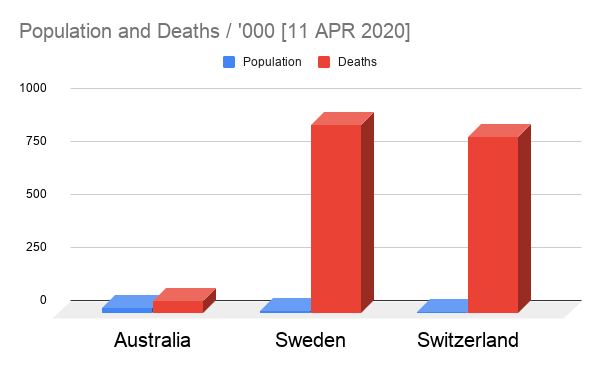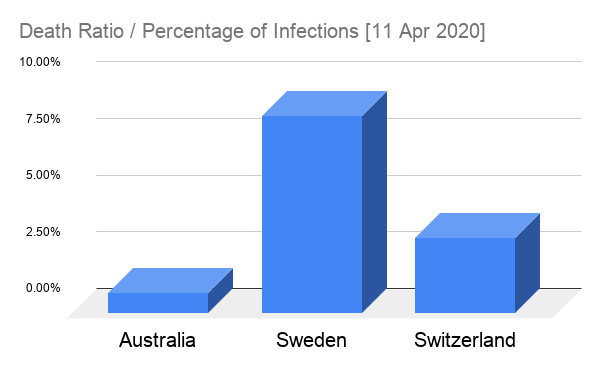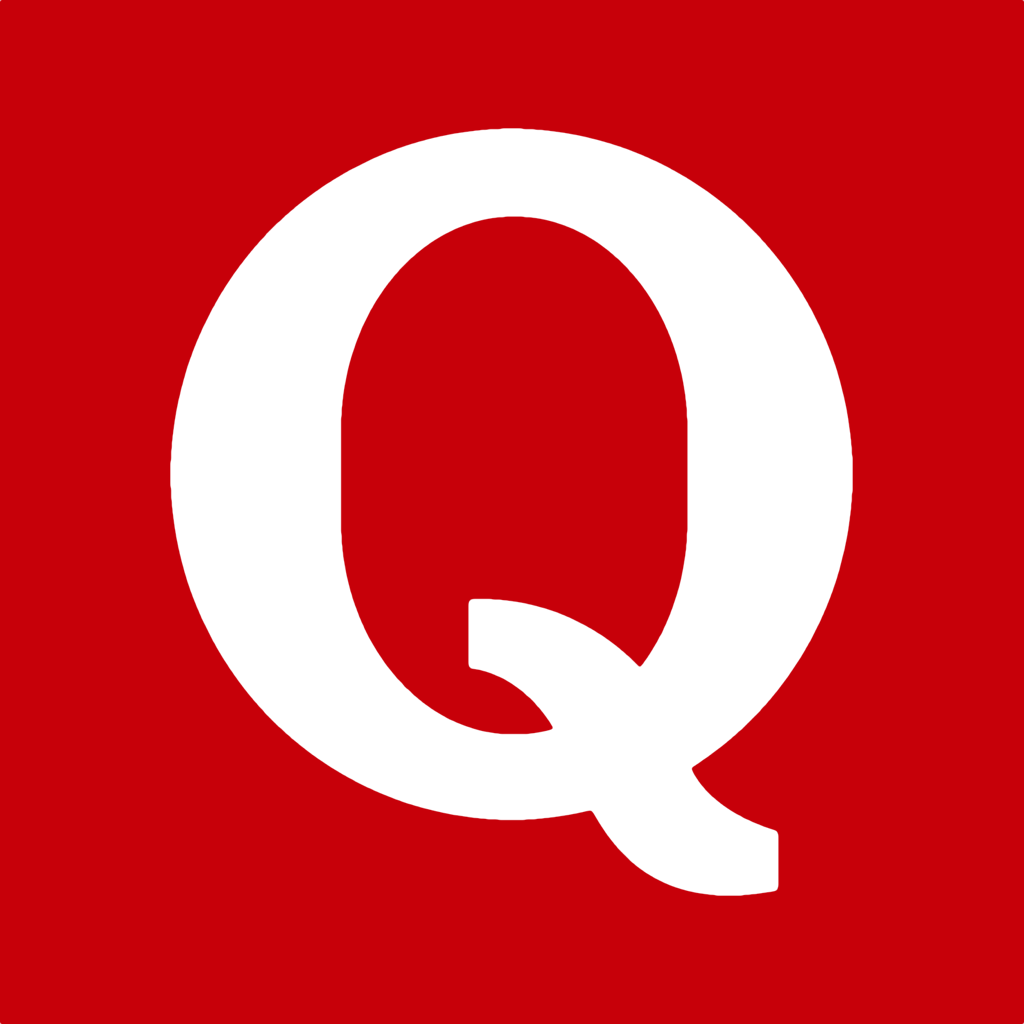|
SEARCH My Blog (Opens in new tab)
How much do testing strategies explain the differences?Switzerland, Sweden and Australia are each taking different approaches to the containment of COVID19. Switzerland is closer to Australia's approach, but not as restrictive, while Sweden is singing to its own tune with a herd immunity approach. Which country is doing the best at this stage? The results might surprise you. Three different approaches each with different outcomesFirstly, let's explore the three different approaches in order of severity of restrictions on their residents. Australia - only two people can meet outdoors Australia, for the past three weeks, has closed gyms, schools, universities, restaurants - and everywhere where more than 2 people gather - and asked people to stay home except for essential needs. We can leave home for medical reasons, to exercise (no more than 2 people), buy food, and if it is absolutely necessary that we have to work outside our home. We cannot go to a holiday house, fish alone, or travel for any purpose not deemed necessary, and many hefty fines have been issued by State police. Switzerland allows gatherings of 5 people Switzerland has something similar (introduced on March 16) to Australia but allows banks and post offices to stay open, and allows gatherings of 5 people in public places (as compared to 2 in Australia). (In fact, in Australia the restriction on 2 people applies to private dwellings whereby the host family counts as 1 person and only 1 single other person may visit them.) Sweden asks people to use their "common sense" Sweden has, somewhat notoriously, chosen to follow a strategy of allowing the virus to spread naturally to reach a point of broad community immunity. The Swedish government has issued "soft instructions" asking people to follow broad social distancing guidelines, based on mutual obligation (although gatherings of over 50 people are banned.) These are the official guidelines: Everyone in Sweden is urged to stay at home if they are at all sick (even a mild cough or sore throat), practice social distancing, avoid non-essential travel within the country, work from home if possible, follow good hygiene practices, and avoid non-essential visits to elderly people or hospitals. People aged over 70 or in risk groups are advised to avoid social contact as much as possible. This is how it was reported recently in Forbes: In Stockholm, a string of sunny early spring days over the Easter holidays have seen plenty of people out to enjoy it. Some appear to keep a distance from those around them, while others make no such efforts. Many grocery stores have now installed plexiglass barriers between cashier and customer, and have put tape down on the floor to indicate how far apart each person in the queue should stand. At the national liquor store Systembolaget, a clerk holds people back at the entrance to make sure there aren't too many people shopping at any given time. Streets downtown remain quieter than usual but there are people out, going to restaurants and so on. The expectation is that Sweden will experience more deaths over a shorter time, which could also mean fewer additional outbreaks in months ahead. That appears to be the way it is playing out. The numbers so far ...Firstly, the top-line numbers - deaths (up to April 11):
But of course, the population sizes are different - Australia has 25 million people, Switzerland 8.6 million and Sweden 10.2 million. On a per-capita basis (below) - Switzerland's infection ratio is 10X that of Australia, 2.9 people per one thousand in Switzerland versus 0.25 in Australia. Sweden's per capita infection rate is one-third of Switzerland's at 0.99 per one thousand people So, unexpectedly, despite the lock-down in Switzerland versus general guidelines in Sweden, Switzerland is suffering much higher infection rates. On the other hand, Australia's lockdown - tighter than Switzerland's, is working exceptionally well so far. Looking at the ratio of deaths to reported infections (below) shows a different story. Sweden's death-to-infection ratio is nearly three times that of Switzerland - 8.74% versus 3.34% - and nearly 10 times Australia's rate of 0.91%. What does it mean?It’s too early to tell what these differences mean in terms of long-term outcome in re-activating each country’s economy while minimising loss of life. What’s puzzling is that Switzerland is doing three times better than Sweden in terms of deaths per infection. The high death ratio in Sweden is even more surprising since a part of Sweden’s relaxed strategy includes a focus on protecting at-risk people — such as older people and those with comorbidity factors such as diabetes. So it doesn’t seem likely that this cohort of people would account for the high death-to-infection ratio. It may be that the testing regime in Sweden is significantly different to Switzerland and Australia. The latest Statistica chart shows that Sweden lags the other Nordic countries in tests per capita, except for Finland. Iceland has conducted 27 tests per thousand people, Norway 8, Denmark 2, and Sweden 1.4 (as of mid-March). As of April 11 Australia had achieved a test ratio of 11.2 tests per 1000 people - sitting in between Iceland and Norway. Switzerland has a similar rate of testing to Australia, perhaps a little higher according to reports over the last few days. Taking the test ratios into account it suggests that the high rate of deaths to infections reported in Sweden is probably related to a low level of testing. A high percentage of tests could be for people that are showing symptoms and already sick. On the weekend of April 10, 1000 immunity test kits were randomly distributed to Stockholm residents to find out what percentage of the metropolitan community had potentially become immune. This is an interesting development. In the future we may start to see the immunity figures reported country by country, which would give more insight into the success of the various containment strategies. What do we conclude?On face value, Australia has achieved the best outcomes so far. If future outbreaks can be contained as restrictions are relaxed, that will be an exceptionally good result. This appears to be because of the early closing of borders (March 20) and a nation-wide lockdown which was mutually agreed by the Federal and State Governments. State Governments have also gazetted new fines for breaching the stay-at-home rules, and fines have been vigorously applied by police. Even members of parliament have been caught and fined - one for visiting his holiday house. Sweden has a bad ratio of deaths to infections compared to Australia and Switzerland, while Switzerland has a much higher number of infections per capita. Since Switzerland has a similar rate of testing as Australia, the difference in the infection rate is puzzling. It could be that Switzerland has tested a different demographic proportion of its population. The fact is, that both Australia and Switzerland still have nearly 99% of their populations untested - so they could be testing very different cohorts of the population. Sweden may need to change course in order to bring the rate of deaths down, and to understand the exact cause of this outlier compared to Switzerland and Australia. On the other hand, if this statistic is simply a reflection of low rates of testing it may stay the course with its herd immunity strategy. Ultimately success will be measured by which country emerges with the fewest and least damaging community-spread shocks. Time will tell. Stay safe. Follow me on Quora for more health and fitness tips.
If you valued this article >> Follow me Leave a comment >> Share it >> Stay healthy If you have any questions email me and I will get back to you. Latest: get your free customised fitness plan designed uniquely for you.
|
ChoicesSince I was diagnosed at 50 with Type 2 diabetes I've been learning how to do bone-building fitness training which lowers my age. You can too. It's your choice. Walter Categories
All
Archives
May 2023
|





 RSS Feed
RSS Feed 


